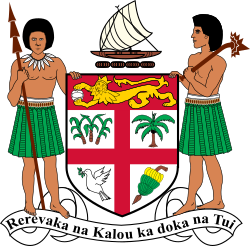Coat of arms of Fiji facts for kids
Quick facts for kids Coat of arms of Fiji |
|
|---|---|
 |
|
| Armiger | Republic of Fiji |
| Adopted | 4 July 1908 |
| Crest | A Fijian Canoe with outrigger in full sail proper |
| Torse | Of the colours |
| Blazon | Argent, a Cross Gules, between in the first quarter three Sugar canes couped, in the second, a Coconut palm also couped, in the third a Dove volant holding in the beak a branch of Olive, and in the fourth a bunch of Banana fruits slipped, all proper, on a chief Gules, a Lion passant guardant, holding between the forepaws a Cocoa pod proper. |
| Supporters | Dexter, a Fijian native affronty, round his waist a Tupu Sulu, holding in the exterior hand a barbed spear all proper, sinister alike native in profile holding in the exterior hand a pineapple club in bend sinister |
| Motto | Rerevaka na Kalou ka doka na Tui "Fear God and honour the King (1 Peter 2:17)" |
| Earlier version(s) |  Kingdom of Fiji |
| Use | 1871-1874 |
The coat of arms of Fiji is a special symbol that represents the country of Fiji. It features a shield divided into four parts by a red cross. At the top of the shield, there is a golden lion.
The shield is held up by two Fijian warriors, one on each side. Above the shield, there is a traditional Fijian canoe. This coat of arms was officially adopted in 1908. Fiji kept this symbol even after it became an independent country in 1970. You can also see the shield from this coat of arms on the flag of Fiji.
Contents
History of the Coat of Arms
Fiji became a colony of the British Empire on October 10, 1874. About 34 years later, on July 4, 1908, Fiji received its own coat of arms. This was made official by a special document called a royal warrant.
Even though the design was meant to be British, it included many symbols important to Fiji. This coat of arms was then used on the flag of the territory. When Fiji gained its independence on October 10, 1970, it decided to keep its coat of arms from the time it was a colony.
One reason for keeping it was its connection to Seru Epenisa Cakobau. He was the first and last King of Fiji before the British took control. However, the coat of arms on the national flag was changed. The canoe, warriors, and motto were removed. Only the shield was left. This made the shield bigger and easier to see on the flag. Some Fijian chiefs have asked for the full coat of arms to be put back on the national flag.
What the Design Means
The colors and objects on the coat of arms have special meanings. They tell a story about Fiji's culture, history, and natural resources.
Symbols on the Shield
The red cross that divides the shield and the golden lion at the top represent the United Kingdom. The UK was the country that ruled over Fiji for many years.
In the four sections of the shield, you can see important crops from Fiji. These include a cacao pod held by the lion, sugarcane, a coconut palm, and bananas. These symbols show the country's natural wealth and important farm products.
The bottom left section of the shield shows a dove. This dove represents peace. A dove was also used on Fiji's flag when King Cakobau was in charge. His government was the last one before British rule began.
Other Important Symbols
The symbol at the very top of the coat of arms is a takia. This is a traditional Fijian canoe. It shows the country's connection to the sea and its heritage.
The two figures holding the shield are Fijian warriors. Legend says they are twin brothers. The older brother holds a spear, and the younger one holds a totokia club. These warriors represent the strength and spirit of the Fijian people.
At the bottom of the coat of arms, there is a motto. It is written in the Fijian language: Rerevaka na kalou ka doka na Tui. This means "Fear God and honour the King."
See also
 In Spanish: Escudo de Fiyi para niños
In Spanish: Escudo de Fiyi para niños

